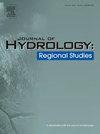Assessing the impacts of extreme precipitation projections on Haihe Basin hydrology using an enhanced SWAT model
IF 4.7
2区 地球科学
Q1 WATER RESOURCES
引用次数: 0
Abstract
Study region
Haihe Basin (HB), North China.
Study focus
Studying the impact of extreme precipitation on watershed hydrological factors plays a crucial role in water resource management, climate adaptation, and disaster resilience. An improved Soil and Water Assessment Tool (SWAT) was employed to assess the impact of extreme precipitation indices (EPIs) on temporal and spatial variations in hydrological factors in the HB, China. Five EPIs were identified in this study, including R10 (moderate rain), R20 (heavy rain), R50 (torrential rain), R95p (95th percentile of precipitation), and R99p (99th percentile of precipitation).
New hydrological insights for the region
The EPIs with the greatest contribution rates to precipitation, water yield, and percolation in the historical period were R20 (32.1 %), R50 (14.3 %), and R20 (29.0 %), respectively, for the entire basin. During the historical period, there were more occurrences of extreme precipitation events in the plain area compared to the mountainous area. In the plain area, rainfall was beneficial for replenishing groundwater when daily precipitation exceeded 50 mm. Over the entire future period (2041–2100), R50 contributed the greatest water yield (18.4 %) and percolation (36.3 %) in the HB. Furthermore, the number of days with rainfall from 20 to 50 mm d−1 and those exceeding 50 mm d−1 increased in the future period relative to the historical period. The results of this study provide a reference for understanding the spatiotemporal distribution pattern of extreme precipitation in the HB and for relevant departments to formulate response strategies.
求助全文
约1分钟内获得全文
求助全文
来源期刊

Journal of Hydrology-Regional Studies
Earth and Planetary Sciences-Earth and Planetary Sciences (miscellaneous)
CiteScore
6.70
自引率
8.50%
发文量
284
审稿时长
60 days
期刊介绍:
Journal of Hydrology: Regional Studies publishes original research papers enhancing the science of hydrology and aiming at region-specific problems, past and future conditions, analysis, review and solutions. The journal particularly welcomes research papers that deliver new insights into region-specific hydrological processes and responses to changing conditions, as well as contributions that incorporate interdisciplinarity and translational science.
 求助内容:
求助内容: 应助结果提醒方式:
应助结果提醒方式:


